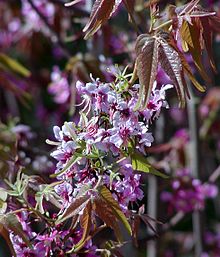| Mexican buckeye | |
|---|---|

| |
| Mexican buckeye flowers | |
| Scientific classification | |
| Kingdom: | Plantae |
| Clade: | Tracheophytes |
| Clade: | Angiosperms |
| Clade: | Eudicots |
| Clade: | Rosids |
| Order: | Sapindales |
| Family: | Sapindaceae |
| Subfamily: | Sapindoideae |
| Genus: | Ungnadia Endl.[3] |
| Species: | U. speciosa
|
| Binomial name | |
| Ungnadia speciosa Endl.[2]
| |

| |
| Natural range | |

Ungnadia is a genus of flowering plants in the family Sapindaceae, containing one species, Ungnadia speciosa, commonly known as the Mexican buckeye. It is native to northern Mexico, as well as Texas and southern New Mexico in the United States.[3][2] The name honors Austrian ambassador Baron David Ungnad von Sonnegg, son of Andreas Ungnad von Sonnegg, who brought the horse chestnut (Aesculus hippocastanum) to Vienna in 1576, introducing the plant into western Europe.[4][5][6][7][failed verification – see discussion]
It differs from the buckeyes in the related genus Aesculus but the seeds and nuts are similar.[8][6][9][10] Another similar related genus is the soapberry (genus Sapindus). Ungnadia seeds are poisonous despite their sweetness, and sometimes used as marbles.[11] The foliage is toxic and rarely browsed by livestock, but bees produce honey from the floral nectar.[6]
- ^ Machuca Machuca, K.; Martínez Salas, E.; Samain, M.-S. (2021). "Ungnadia speciosa". IUCN Red List of Threatened Species. 2021: e.T126621644A136785643. doi:10.2305/IUCN.UK.2021-1.RLTS.T126621644A136785643.en. Retrieved 5 August 2023.
- ^ a b Cite error: The named reference
GRIN2was invoked but never defined (see the help page). - ^ a b Cite error: The named reference
GRIN1was invoked but never defined (see the help page). - ^ Cite error: The named reference
CRC1was invoked but never defined (see the help page). - ^ Cite error: The named reference
SE1841was invoked but never defined (see the help page). - ^ a b c Cite error: The named reference
Audubon1was invoked but never defined (see the help page). - ^ Cite error: The named reference
SE1839was invoked but never defined (see the help page). - ^ Cite error: The named reference
Seeds1was invoked but never defined (see the help page). - ^ Cite error: The named reference
USDA1was invoked but never defined (see the help page). - ^ Cite error: The named reference
USDA2was invoked but never defined (see the help page). - ^ Cite error: The named reference
Stahl1was invoked but never defined (see the help page).
